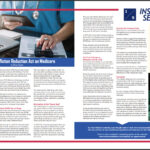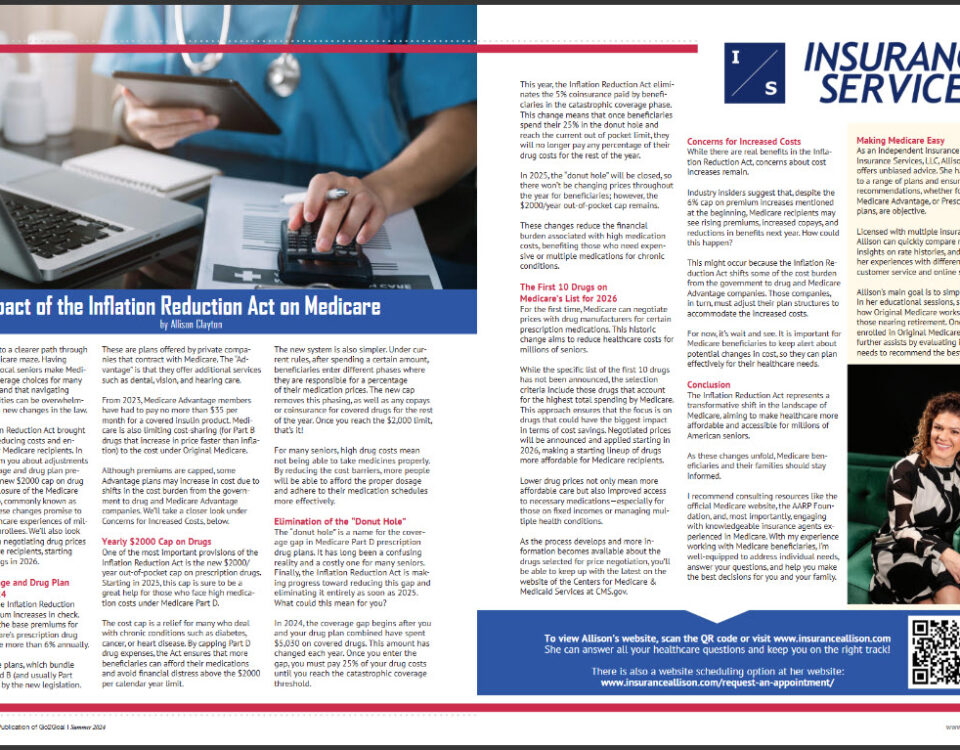
Impact of the Inflation Reduction Act on Medicare
August 21, 2024
Medicare Drug Price Negotiation: What You Need to Know
Welcome to a clearer path through the Medicare maze.
Let’s talk about Medicare Drug Price Negotiation. If you’ve felt overwhelmed by Medicare’s layers of coverage and costs, you’re not alone. Luckily there is always someone to turn to, especially in a time of changing coverage. Today, let’s take a look at The Inflation Reduction Act of 2022 and what it means to Medicare recipients just like you.
There’s good news! For the first time, Medicare can directly negotiate prices on certain high‑cost, single‑source prescription drugs. As your independent insurance agent, I’m excited to walk you through how this new program works. We’ll take a look at what’s happening in 2026 and then highlight the top five drugs selected for the 2027 pricing cycle. I’ll explain the timeline for key actions and public input and show you how to stay informed so you can make the best choices for your health and budget.
How the Negotiation Program Works
Under the new law, Medicare can now negotiate prices for some expensive medicines. Each year, Medicare chooses a new group of drugs to negotiate. For each drug selected, Medicare works with manufacturers to set a lower “negotiated price.”
The first group of 10 drugs has already been chosen, and their lower prices will start on January 1, 2026. A second group of 15 different drugs has also been selected, including the five we will highlight in this article. Their lower prices will begin one year later, on January 1, 2027. Each cycle includes new drugs, gradually making medications more affordable over time.
Drugs Selections for 2026
In 2026, Medicare will implement lower prices for ten widely used and costly prescription drugs. This first group includes medications such as Eliquis and Xarelto for blood clots, Jardiance and Farxiga for diabetes and heart failure, Januvia for diabetes, Entresto for heart failure, Enbrel and Stelara for autoimmune conditions like arthritis and psoriasis, Imbruvica for blood cancers, and insulin products like Fiasp and NovoLog.
These drugs were picked based on their high Medicare spending and lack of generic alternatives. Based on projections by the Centers for Medicare & Medicaid Services (CMS), the negotiated prices are expected to save Medicare beneficiaries approximately $1.5 billion in out-of-pocket expenses and Medicare about $6 billion in 2026. Of course, actual savings may vary depending on final prices and utilization (Source: CMS, 2024)
Drugs Selections for 2027
On January 17, 2025, CMS published its list of fifteen drugs slated for negotiation in the second cycle, based on total gross covered Part D prescription costs from November 1, 2023, through October 31, 2024. The top five by spending were:
- Ozempic; Rybelsus; Wegovy – These GLP-1 therapies containing semaglutide are widely prescribed for type 2 diabetes and weight management. With a combined $14.4 billion in Medicare spending, they top the list for 2027.
- Trelegy Ellipta – This triple‑therapy inhaler for asthma and COPD accounted for over $5.1 billion in Part D costs and served about 1.25 million enrollees.
- Xtandi – As a leading prostate cancer treatment, Xtandi generated $3.16 billion in spending for roughly 35,000 Medicare users.
- Pomalyst – Used in multiple myeloma and Kaposi’s sarcoma, Pomalyst’s $2.07 billion tab impacted about 14,000 beneficiaries.
- Ibrance – A key breast cancer drug, Ibrance accounted for nearly $1.98 billion in Medicare Part D costs, covering around 16,000 patients.
The remaining 10 drugs on the negotiation list for 2027 include treatments like Ofev for pulmonary fibrosis, Linzess for chronic constipation, Calquence for chronic leukemia, and Austedo for conditions like Huntington’s disease and tardive dyskinesia. Other drugs on the list address mental health conditions, such as Vraylar for bipolar disorder and schizophrenia, and chronic inflammatory conditions, including Otezla for psoriasis and psoriatic arthritis.
Additional diabetes and respiratory medications like Tradjenta, Janumet, Breo Ellipta, and Xifaxan for digestive conditions are also part of the negotiation. Lower drug costs mean people with chronic or life-threatening conditions can stick to their prescribed treatments without skipping doses or cutting pills to save money, greatly improving their overall health and quality of life.
You can learn more at: https://www.cms.gov/files/document/factsheet-medicare-negotiation-selected-drug-list-ipay-2027.pdf
Timeline and Public Engagement
Medicare started working on drug price negotiations long before announcing which drugs would be included. In early 2024, Medicare shared a draft of how negotiations would work and asked the public for comments. By October 2024, they finalized the rules.
After announcing the list of drugs in January 2025, drug companies had until the end of February to join the process. CMS will likely host public meetings in spring 2025 to gather input from patients, caregivers, and providers. Initial price offers are anticipated around mid-2025, with manufacturers responding within a month. Final negotiated prices are expected to be announced by late 2025, effective January 1, 2027.
Why It Matters to You
Lower negotiated prices mean less out‑of‑pocket spending on your prescriptions. While exact savings depend on your plan’s structure, early estimates project that Medicare beneficiaries will save $1.5 billion in 2026 on the first ten negotiated drugs.
As more cycles roll out, savings grow. For those on fixed incomes or managing chronic conditions, even modest price reductions translate into fewer skipped doses and less financial stress. Imagine paying tens or hundreds less each month for drugs that once strained your budget.
The negotiation program aims to lower prices for selected drugs, which may encourage manufacturers to consider more competitive pricing strategies over time.
Stay Informed
For plain-language summaries and Medicare plan comparisons, Medicare.gov is your go-to resource. The AARP Foundation and Kaiser Family Foundation also publish easy-to-read guides. Finally, your local insurance agent or broker can provide side-by-side plan quotes showing how the new negotiated prices affect your benefits.
Making Medicare Easy
As an independent insurance agent with Insurance Services, LLC, Allison Clayton offers unbiased advice. She has access to a range of plans and ensures her recommendations, whether for Medigap, Medicare Advantage, or Prescription drug plans, are objective.
Licensed with multiple insurance carriers, Allison can quickly compare rates, provide insights on rate histories, and share her experiences with different carriers’ customer service and online systems.
Allison’s main goal is to simplify Medicare. In her educational sessions, she explains how Original Medicare works and helps those nearing retirement. Once they’re enrolled in Original Medicare, Allison further assists by evaluating individual needs to recommend the best plan.
Visit Allison’s website at https://www.insuranceallison.com/. She can answer all your healthcare questions and keep you on the right track!



